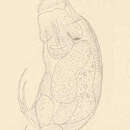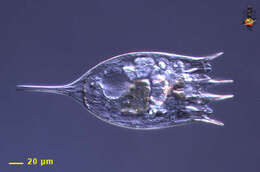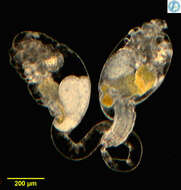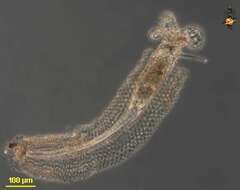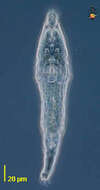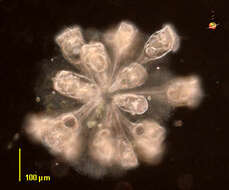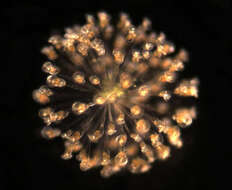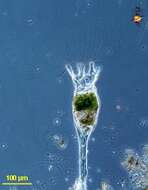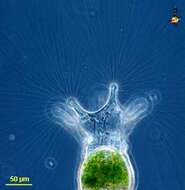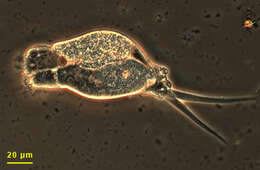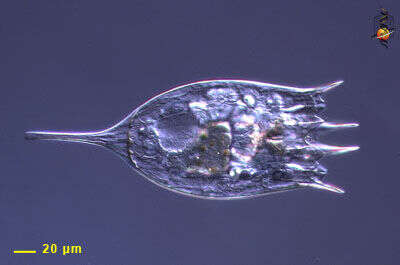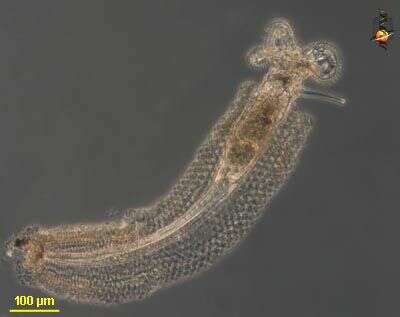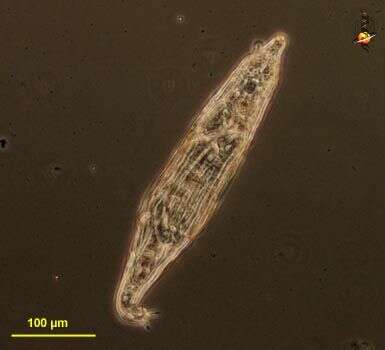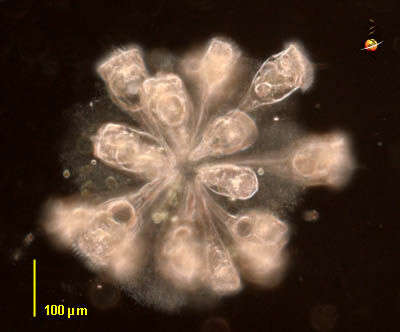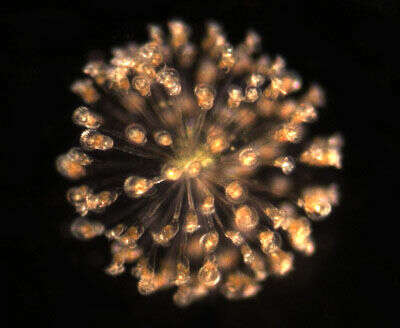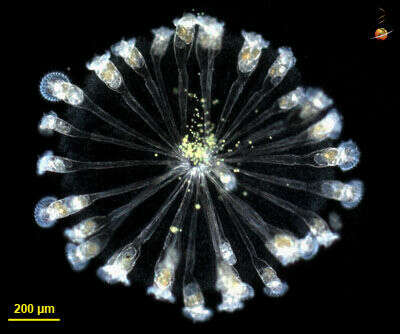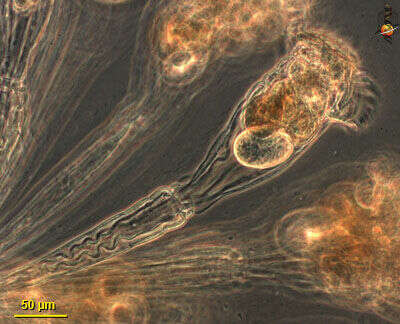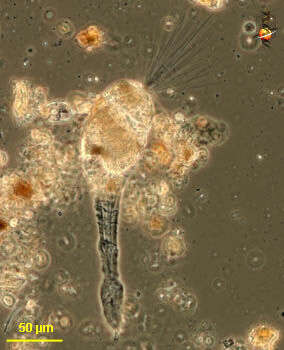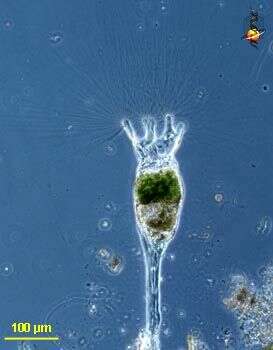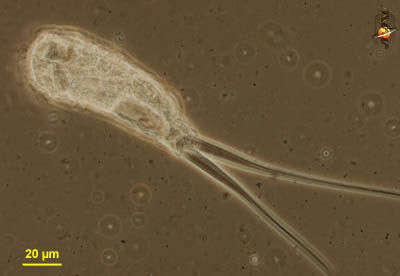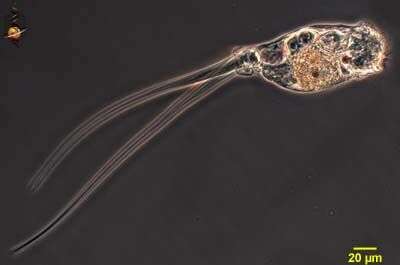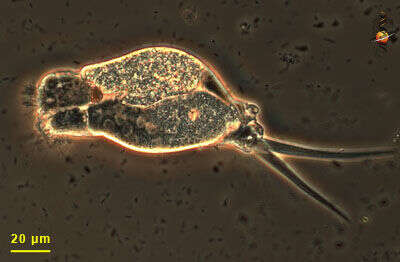-
A somewhat withdrawn individual - rotifers can be like that. Differential interference contrast optics.
-
Clusters of these rotifers with prehensile and flexible stalks were occasionally found in Lake Donghu, China. Generic identification by Hendrik Seegers. Phase contrast micrograph.
-
Floscularia (floss-cue-lair-ee-a) an illoricate rotifer (metazoa), lives within a test, the walls of which are made up of pellets constructed by the animal in a specialized organ on the head. Feeds with an array of cilia (called a corona) which is made up of four lobes. With lateral projections called antennae. Phase contrast.
-
Adineta (add-in-eat-a), a rotifer (metazoa). Rotifers typically have stiffened body wall. The corona is retracted in the anterior part of the body in this specimen - visible as the pair of elliptic structures just above the V-shape of the mouth. Phase contrast, text by Hendrik Seegers.
-
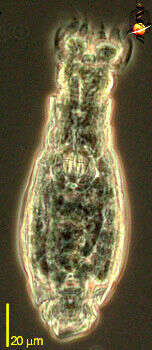
This is a bdelloid rotifer (metazoa), body with a stiffened body wall (lorica) usually in elements that will telescope, posterior end often with two spurs. Very common in aquatic habitats especially those which are prone to dry out - like moss, soils and the contents of pitcher plants. They can resist drying because they can perform cryptobiosis - that is they can dry out completely, and the organisms can come back to life when wetted. Usually eat bacteria or suspended protists, using the cilia of the corona at the front end of the body to sweep particles into the front of the body where an armoured mastax or jawed pharynx helps to grind the food. Rotifers are common members of the microbial communities of many aquatic ecosystems. Although they are multicellular animals, they may be only 100 microns long, and so overlap in size with ciliates. They can be confused with ciliates because they use cilia to capture their food. However, they can be distinguished because many have an exoskeleton and a muscular pharyngeal region just behind the head. Phase contrast.
-
Rotifers typically have stiffened body wall. The corona is retracted in the anterior part of the body in this specimen - visible as the pair of elliptic structures just above the V-shape of the mouth. Phase contrast, text by Hendrik Seegers. Phase contrast.
-
Conochilus (cone-ow-kile-us), this is a colonial rotifer (metazoa), in which the basal parts of the rotifers are embedded in a common gelatinous matrix. The feeding areas, the coronas, project outwards. Rotifers are common members of the microbial communities of many aquatic ecosystems. Although they are multiceullar animals, they may be only be 100 microns long, and so overlap in size with ciliates. They can be confused with ciliates because they use cilia to capture their food. However, they can be distinguished because they have an exoskeleton, usually two posterior toes, and a tough pharyngeal region just behind the head. Dark ground illumination.
-
Colonial planktonic rotifer forms colonies up to several millimetres in diameter. This is an unconstrained colony.
-
Colonial rotifer, crompressed between slide and coverslip. The organisms are joined at their toes and are embedded in a fine mucus. All colonies at this site had green algae near their cores. The metachronal beat of the cilia is seen in some organisms.
-
One organism from a colony. Phase contrast optics.
-
Collotheca (coll-o-thee-ka) is a rotifer (metazoa) and is fairly distinctive because of the long stiff setae. The organism may contract. Rotifers are common members of the microbial communities of many aquatic ecosystems. Although they are multiceullar animals, they may be only be 100 microns long, and so overlap in size with ciliates. They can be confused with ciliates because they use cilia to capture their food. However, they can be distinguished because they have an exoskeleton, usually two posterior toes, and a tough pharyngeal region just behind the head.
-
Collotheca (col-owe-theek-a) a rotifer, with long cilia used to capture food. Contractile, and with its anterior ciliary organ, the corona, developed into 5 lobes. Often also with mucus around the stalk, but this is not evident here. Phase contrast.
-
Collotheca (col-owe-theek-a) a rotifer, with long cilia used to capture food. Contractile, and with a 5 lobes exoskeleton. Often also with mucus around the stalk, but this is not evident here. The cilia are emphasised in this image. Phase contrast.
-
Rotifer, with two stiff blades to either side of the body and these can be extended. From Lake Donghu, China. Generic identification by Hendrik Seegers. Phase contrast micrograph.
-
Believed to be the egg of a rotifer. From Lake Donghu, China. Identified to genus by Hendrik Seegers. Phase contrast micrograph.
-
Monommata (mon-owe-mat-a), a rotifer (metazoa). Rotifers typically have an exoskeleton in segments which can telescope, with a corona of feeding cilia at the anterior end and with toes or podites posteriorly. This genus has very strongly developed toes, and muscle fibres can be seen within the toes. The toes can flick suddenly. Rotifers are common members of the microbial communities of many aquatic ecosystems. Although they are multiceullar animals, they may be only be 100 microns long, and so overlap in size with ciliates. They can be confused with ciliates because they use cilia to capture their food. However, they can be distinguished because they have an exoskeleton, usually two posterior toes, and a tough pharyngeal region just behind the head.
-
Monommata, a rotifer with two very long posterior spines. The spines are motile and can flex. Phase contrast micrograph.
-
This rotifer has two very long and retractible 'toes'. The ingestion region is to the left - some cilia of the wheel organ are visible. The body includes an ovary (lower) and gut (upper). Phase contrast microscopy.

